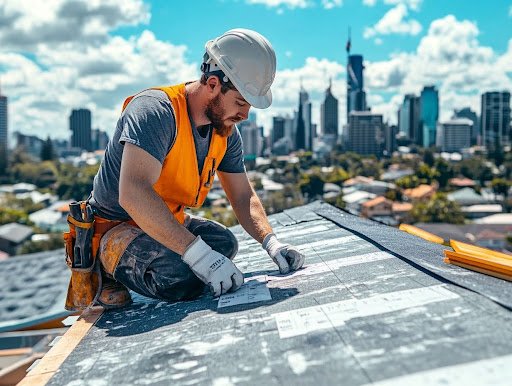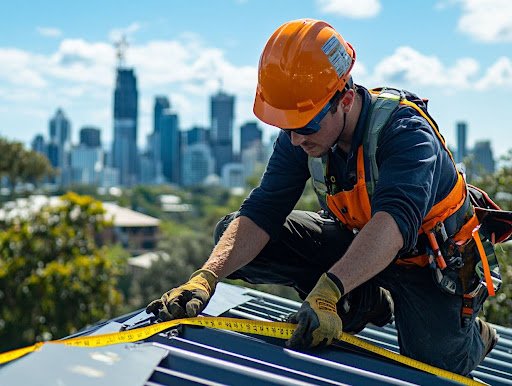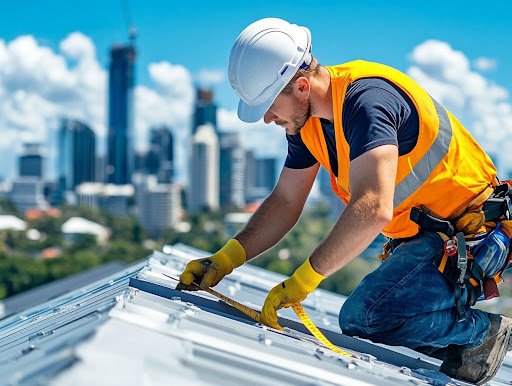Roof Replacement Quotes Brisbane: What to Expect
- Trusted Roofing Professionals Brisbane
- Free Quotes Available
- Contact Us Now
The roof constitutes one of the most vital components of a home, offering essential protection and contributing to its occupants’ overall peace of mind. Determining when a roof requires replacement can be challenging, as factors like material and cost need careful assessment. This guide explores the critical indicators that signify the need for urgent attention to your roof, such as structural damage and leaks. It will also discuss the associated costs in Brisbane and outline the systematic roof replacement process, including necessary equipment and labour. Furthermore, the guide offers insights into selecting a reputable roofing company, ensuring that your project is executed efficiently and effectively, with appropriate insurance coverage. Explore this comprehensive resource to understand roof replacements in Brisbane thoroughly.
Key Takeaways:
- A roof replacement is necessary when signs of damage, such as leaks, cracks, and mould, are present.
- The roof replacement cost in Brisbane is affected by factors such as roof size, materials, and labour.
- The roof replacement process in Brisbane includes inspection, choosing materials, obtaining permits, removing old materials, installation, and final inspection.
Why Do You Need a Roof Replacement?
A roof replacement is crucial for preserving the safety, structural integrity, and aesthetic appeal of residential properties in Brisbane, particularly when addressing water damage and potential leaks.
Over time, roofs can deteriorate due to prolonged exposure to harsh weather conditions, resulting in potential damage and leaks that may compromise the building’s safety. While regular maintenance is essential, there are instances when wear and tear exceed repair capabilities, necessitating a complete re-roofing with new materials. This not only safeguards the property but also enhances its overall value.

Signs That Your Roof Needs to Be Replaced
Identifying signs that indicate the need for a roof replacement is essential for preventing extensive damage to one’s home and ensuring the building’s energy efficiency. Common indicators include visible leaks, missing tiles, sagging areas, and excessive granule loss from asphalt shingles. Regular inspections can aid in the early detection of these issues; however, if any of these warning signs are observed, it is advisable to consult a roofing contractor for a professional assessment.
Several additional symptoms may suggest that a roof replacement is imminent. For instance:
- Water stains on ceilings or walls are clear indications of leaks.
- Mould growth, particularly in loft spaces, may signify trapped moisture.
- Shingles that are curled, cracked, or exhibit significant wear may indicate the necessity for replacement.
- Rooftops over 20 years old should be examined closely for age-related wear.
Taking timely action in response to these observations can help mitigate further damage to the home’s interior, which can lead to costly repairs and potential health hazards. Consulting a professional can provide clarity and peace of mind regarding the roof’s condition.
How Much Does a Roof Replacement Cost in Brisbane?
Homeowners must understand the cost of roof replacement in Brisbane to budget effectively for this significant investment. The average price may vary based on several factors, including the roof size, the type of materials selected (such as Colorbond or tiles), and the complexity of the installation process.
By obtaining multiple quotes from reputable contractors, homeowners can ensure they receive a fair price while maintaining high-quality standards.
Factors That Affect the Cost of Roof Replacement
Several factors directly influence the roof replacement cost, affecting homeowners’ financial expectations in Brisbane. Key considerations include the choice of roofing material, such as asphalt shingles or Colorbond, the labour costs associated with skilled contractors, and any necessary structural repairs that may arise during installation.
Along with these fundamental aspects, it is essential to recognise that local market trends for materials can affect roof replacement pricing, which may fluctuate based on supply and demand. For example, while asphalt shingles are a popular choice due to their cost-effectiveness, prices may increase if certain styles or colours are in high demand.
Labour rates can vary significantly, depending on the contractors’ experience level and the project’s complexity, such as the roofing material used. Additional expenses should also be considered in the overall financial assessment; permits are often required for roofing projects in Brisbane, which can further increase the cost and insurance to mitigate potential liabilities. Homeowners should also account for unforeseen repairs that may arise once the old roof has been removed, potentially leading to additional costs.
Understanding these elements can significantly enhance a homeowner’s preparation for the forthcoming roofing project.

Roof Replacement Process in Brisbane
The roof replacement process in Brisbane involves a series of systematic steps to ensure successful installation while minimising disruption to the household.
Initially, a qualified contractor conducts a thorough inspection and assessment to identify the extent of the damage and determine the appropriate roofing materials required. Subsequently, acquiring the necessary permits, removing the old materials, and installing the new roof are all critical stages contributing to the integrity and longevity of the latest roofing system.
Step 1: Inspection and Assessment
The initial step in the roof replacement process involves a comprehensive inspection and assessment conducted by a qualified roofing contractor. This critical phase evaluates the roof’s current condition, identifies any underlying damage, and determines whether a complete replacement is necessary or if repairs would suffice. Factors such as the roof’s age, the extent of leaks, and the structural integrity are considered during this evaluation.
During the inspection, contractors meticulously examine common issues, including missing tiles, signs of water damage, and the condition of flashing around vents and chimneys. They may also assess the gutters for blockages or leaks, as these factors can significantly affect the longevity and performance of the roof.
This thorough analysis empowers homeowners to make informed decisions regarding their roofing system, which can impact immediate and long-term financial considerations. By understanding the extent and nature of the issues, homeowners can prioritise necessary repairs or explore replacement options, ensuring that the roof remains secure and effectively safeguards their property.
Step 2: Choosing the Right Roofing Materials
Selecting the appropriate roofing materials is essential for ensuring durability, energy efficiency, and aesthetic appeal for a new roof. Homeowners in Brisbane have various options, including popular choices such as Colorbond, asphalt shingles, metal roofing, and tiles. Each material presents distinct advantages and potential disadvantages that must be meticulously evaluated during selection to align with specific needs and budgetary constraints.
A comprehensive understanding of the various roofing materials can significantly influence long-term satisfaction with one’s home. For example, Colorbond is highly esteemed for its resilience and contemporary appearance, while asphalt shingles are frequently favoured for their cost-effectiveness. Metal roofing is recognised for its durability and capacity to reflect heat, enhancing energy efficiency, whereas tile roofing offers a classic aesthetic that appeals to many homeowners.
Consequently, homeowners should consider the following factors, including the potential price of each roofing option:
- Cost: Assessing the initial investment against potential long-term savings.
- Longevity: Evaluating the lifespan of materials and warranty options.
- Energy Efficiency: Understanding how materials can contribute to reduced heating and cooling expenses.
- Design: Selecting a style that harmonises with the home’s architectural features.
Ultimately, weighing personal preferences against local climate conditions will facilitate knowledge-based decision-making and ensure a satisfactory roofing choice.

Step 3: Obtaining Necessary Permits
Before commencing the reroofing and roof replacement, it is imperative to obtain the necessary permits to ensure compliance with local regulations in Brisbane. These permits are essential for guaranteeing that the roofing installation adheres to safety and building codes, thereby protecting the homeowner and contractor. Homeowners should work closely with their roofing contractor, who can provide assistance in navigating the permit process and offer guidance on the specific requirements applicable to their area.
Securing the appropriate roofing permits is vital for legal compliance and facilitating a smooth replacement process. Failing to obtain these essential documents may expose homeowners to potential fines and the risk of having to dismantle completed work.
Neglecting this critical step can lead to significant delays in the project timeline, as inspections may be required before any work can proceed.
- Permits help ensure that the new roof is both safe and durable.
- Proper execution of permit procedures can prevent future legal complications.
- In some instances, the absence of necessary documentation may jeopardise insurance claims.
Understanding the importance of permits and compliance with local roofing regulations can significantly enhance the likelihood of a successful roof replacement project.
Step 4: Removing Old Roofing Materials
The fourth step in the roof replacement process involves the meticulous removal of old roofing materials, which is essential for preparing the installation of new roofing. This step must be carried out by experienced contractors to prevent any damage to the underlying structure of the roof and to mitigate any risks associated with potentially hazardous materials that may be present.
During this critical phase, professionals typically employ roofing knives and pry bars to efficiently strip away aged shingles, tiles, or metal sheets. Adherence to established safety protocols is paramount, including protective gear such as hard hats, gloves, and harnesses to safeguard against falls and injuries.
Individuals engaged in this process must remain vigilant for potential challenges, including:
- Identifying and safely handling hazardous materials, such as asbestos or old nails.
- Addressing unexpected moisture damage or structural integrity issues that may complicate the removal process.
- Managing debris prevents accidents during the removal phase and maintains a clean workspace.
By exercising caution and possessing the requisite expertise, roofing professionals can effectively navigate these challenges, ensuring a seamless transition to the new roofing installation.
Step 5: Installing New Roofing Materials
Installing new roofing materials represents the final stage of the roof replacement process, during which skilled contractors meticulously fit and secure the selected materials to the home’s structure. This phase necessitates a high level of expertise to ensure proper installation and strict adherence to safety standards and manufacturer guidelines, which are crucial for maximising the new roof’s durability and effectiveness.
Various roofing materials possess unique installation methods that significantly impact their long-term performance. For example, asphalt shingles are typically installed in overlapping layers, providing effective water resistance and protection against leaks, while Colorbond offers a modern and durable solution. In contrast, metal roofing employs interlock panel systems to create a secure seal against harsh weather conditions.
Slate and tile roofing require the expertise of skilled artisans to ensure that each component fits precisely, thereby preventing slippage and enhancing durability. Engaging qualified professionals is paramount for their technical skills and capability to assess structural integrity and develop customised solutions that conform to specific building codes.
- Asphalt Shingles: Overlapping layers for water resistance.
- Metal Roofing: Interlocking panels for weatherproofing.
- Slate and Tile: Artisanal techniques for durability.
This comprehensive approach to installation improves the roof’s ability to withstand adverse environmental conditions and enhances its overall aesthetic appeal.

Step 6: Clean-up and Final Inspection
The final step in the roof replacement process entails a comprehensive clean-up and final inspection to verify that the installation has been carried out to the highest standards. Following the removal of the old materials and the installation of the new roof, contractors will clear the site of any debris and conduct a thorough examination to ensure compliance with the necessary safety and quality standards.
This stage is essential as it directly influences customer satisfaction and the roof’s long-term performance. A meticulous clean-up fosters a tidy environment and reassures clients that their investment has been managed with diligence.
Reputable contractors frequently offer follow-up services, which may include:
- Routine maintenance checks
- Emergency repair services
- Comprehensive warranties covering repairs and materials
These services help cultivate trust and confidence, assuring homeowners they can depend on the contractor well beyond the installation phase. By prioritising these elements, contractors ensure that clients feel valued, which promotes a positive experience and encourages future recommendations and business.
How Long Does a Roof Replacement Take in Brisbane?
The duration of a roof replacement in Brisbane can vary significantly due to several factors, including the size of the roof, the type of materials being installed, and the experience level of the contractor involved.
On average, homeowners can anticipate that the roof replacement process will take anywhere from a few days to several weeks, depending on the project’s complexity and prevailing weather conditions.
Various factors can substantially influence this timeframe, thereby affecting the overall efficiency of the work. For example, weather delays may lead to unexpected interruptions, particularly in areas prone to storms or heavy rainfall. Additionally, the availability of specific materials is critical; if a particular roofing style or colour is in high demand, delays in procuring these supplies may extend the project timeline.
The contractor’s efficiency is also a key determinant of how quickly the work can progress. Homeowners are advised to maintain open lines of communication with their contractors to establish realistic scheduling expectations and ensure that all parties involved are aligned regarding proper timelines.
- Weather conditions: Storms and rain can cause work stoppages.
- Material availability: Popular styles may lead to project delays.
- Contractor efficiency: Experienced workers tend to complete jobs more quickly.
Tips for Choosing the Right Roofing Company in Brisbane
Choosing the appropriate roofing company in Brisbane is essential for achieving a successful roof replacement, as the quality of workmanship significantly influences the longevity and performance of the new roof. Homeowners should prioritise contractors with demonstrated experience, favourable customer reviews, and appropriate insurance coverage to mitigate potential liabilities during installation.
To commence a comprehensive evaluation, obtaining multiple quotes from various contractors to compare pricing and services is advisable. This approach not only aids in understanding the prevailing market rates but also illuminates the diverse options available, enhancing the decision-making process. Additionally, verifying references and requesting a portfolio of previous work offers valuable insights into the quality and reliability of a contractor.
It is prudent to pose the following questions:
- What type of materials do you use?
- Do you provide any warranties on your work?
- How do you address unforeseen issues that may arise during the project?
Inquiring about warranties and insurance is of the utmost importance. Reputable roofing companies in Brisbane should maintain liability insurance and offer guarantees on their workmanship. This level of diligence ensures that homeowners can have confidence in their investment, knowing they are securing quality workmanship and materials.
Conclusion
A roof replacement represents a significant investment for homeowners in Brisbane, as it is essential for maintaining the safety and integrity of the building. Understanding the process, associated costs, and the importance of selecting a reputable contractor is crucial for achieving a successful and durable installation that enhances the property’s value and protects it from environmental elements.
Timely roof replacements in Brisbane prevent costly repairs in the future and provide peace of mind, ensuring that the home is safeguarded against severe weather conditions. Regular maintenance is vital in extending the roofing system’s lifespan, as neglecting it can result in issues that may compromise its effectiveness. Consequently, homeowners are encouraged to:
- Schedule periodic inspections to identify potential problems early
- Invest in high-quality materials such as Colorbond during the replacement process
- Seek professional advice when considering upgrades
Taking proactive measures to ensure proper care and maintenance will enhance the property’s kerb appeal and preserve its overall value.
Investing in your roof today can lead to substantial savings and comfort in the future.
Frequently Asked Questions
What factors affect the cost of roof replacement quotes in Brisbane, including Colorbond options?
The cost of roof replacement quotes in Brisbane can vary depending on several factors, including the size and complexity of your roof, the materials used, and the experience of the roofing contractor. Additional factors, such as the location of your home and any necessary permits, can also impact the cost.
How long does it take to receive a roof replacement quote in Brisbane?
The timeframe for receiving a roof replacement quote in Brisbane can vary depending on the availability of roofing contractors and the complexity of your project. However, most reputable companies can provide you with a quote within one to two weeks.
What should I expect during the roof replacement process in Brisbane?
The roof replacement process in Brisbane typically involves several steps, including an initial inspection and quote, removal of the old roof, installation of the new roof, and final clean-up. Your roofing contractor should keep you informed throughout the process and address any concerns or questions you may have.
Are there any special requirements for roof replacement in Brisbane?
Yes, there are specific requirements and regulations for roof replacement in Brisbane. This may include obtaining necessary permits and following building codes. It is essential to hire a reputable roofing contractor who is knowledgeable about these requirements and can ensure that your roof replacement is done correctly.
Can I negotiate the price of a roof replacement quote in Brisbane?
While it is always worth discussing pricing with your roofing contractor, it is essential to remember that quality roof replacement work comes at a cost. A reputable contractor will provide a fair and competitive quote based on your project’s specific needs and the required materials and labour.
What kind of warranty or guarantee should I expect with my roof replacement in Brisbane?
Different roofing contractors may offer different warranties or guarantees for their work. It is essential to ask about this before hiring a contractor. Reputable companies will typically provide a warranty on the materials used and a guarantee for their workmanship. Review and understand the terms of any warranties or guarantees provided.
